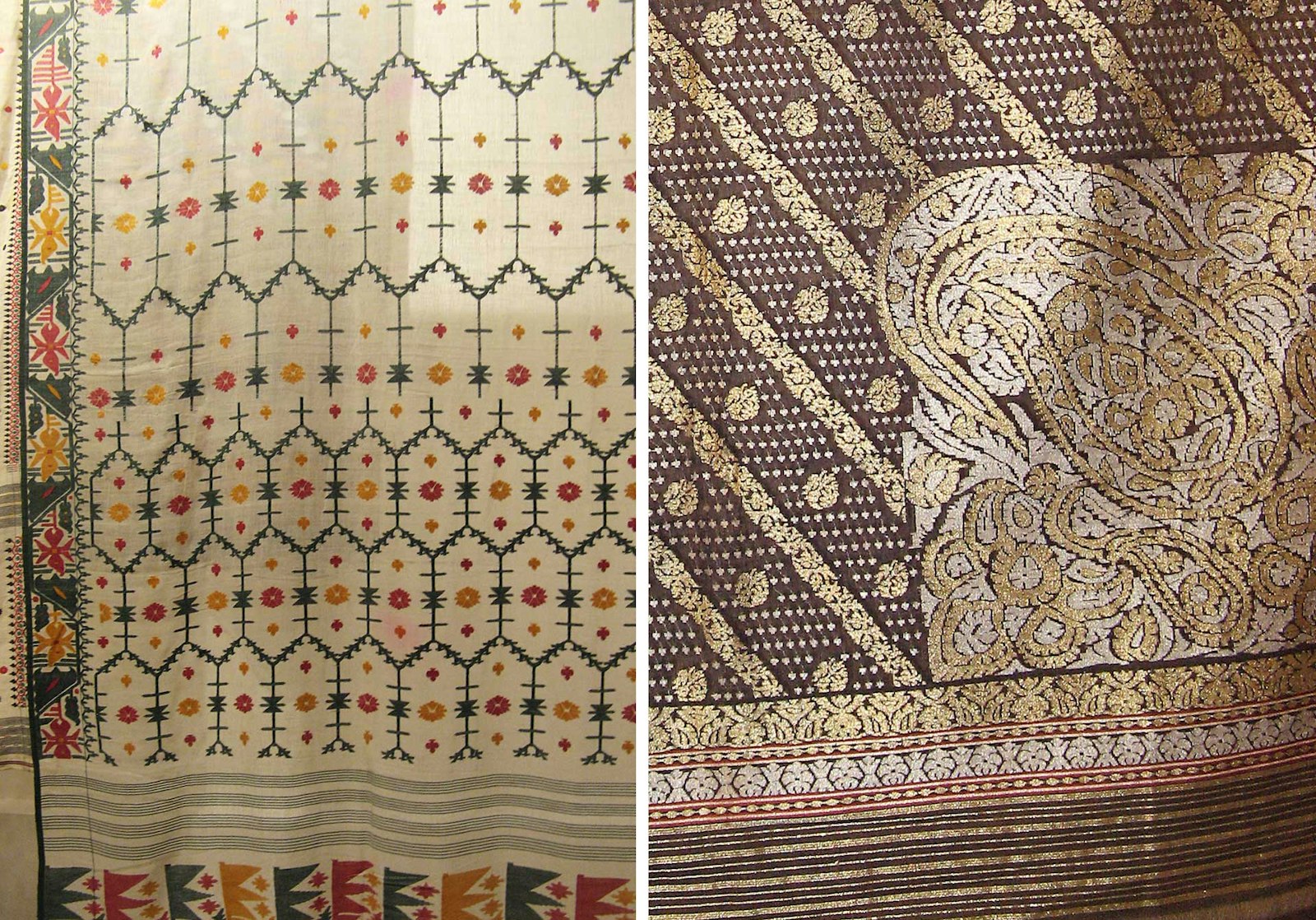Many handweavers like use fine threads but here is Chitra Balasubramaniam with a description of and story about fabrics so thin and fine they seem almost magical. -Susan
Amir Khusro, the famous thirteenth-century Sufi poet, described fine handspun, handwoven cotton so fine that 100 yards could pass through a needle, with a transparency more like water than cloth. He described a fabric so beautiful that it was likened to air, moonlight, clouds, and water: magnificent muslin. In reality, the fabric was so fine that several layers could pass through a signet ring, and it was so light that if washed and tossed in the air, it would dry before landing. Poetry, romance, royalty, legendary tales, trade worth a king’s ransom, secrecy, cutthroat competition—these are all part of the history of muslin and especially the decorative muslin known as jamdani.
The term jamdani seems to be from the Persian words jama, meaning robe, and dani, meaning floral vase or floral motifs. No one really knows how or when the jamdani technique originated, though it seems to have reached its zenith during the Mughal Empire that began in the 1500s and lasted into the 1800s. Royalty wore silks and velvets during winters, and in summers, they wore finely woven jamdani. White-on-white motifs were the defining characteristic of jamdani during this period.

Left: Close-up of jamdani weaving on muslin on the loom, showing the needle and the motifs akin to embroidery. Right: Jamdani weave on the pallav (decorative end) of a saree.
Jamdani is referred to as extra-weft ornamentation, on-loom embroidery, or discontinuous weft. The patterns are developed on graph paper and fastened under the warp. A weaver then painstakingly works the on-loom embroidery using needles or extra weft shuttles, creating each motif individually. Jamdani weaving is indelibly linked to muslin, which is the ground cloth on which jamdani is woven. To understand jamdani weaving, one needs first to understand muslin.
During muslin’s heyday, the finest examples came from the city of Dhaka in what is now Bangladesh. There, the fabric was known as daccia mul. Such was the fineness of the fabric that the daughter of the Mughal emperor Aurangzeb was reprimanded for wearing transparent fabrics, after which she clarified that she was swathed in seven layers of cloth. Daccia mul was so exquisite that when the city was under British rule, orders were given to cut off the thumbs of weavers to prevent competition with milled British fabrics.

A rare jamdani piece with borders and pallav woven in a multitude of shades on fine cotton muslin.
Though jamdani is historically associated with Dhaka, today it is mostly woven in Kalna, India, where many Bangladeshi weavers who migrated to India set up their looms. Jamdani is also woven in other areas of India: Assam, Manipur, Tanda in Uttar Pradesh, and Uppada in Andhra Pradesh. Each of these weaving centers is linked to royalty who were historically great patrons of muslin.
You can also find muslin weavers in the state of Tamil Nadu, which is where I met the weaver Jyotish Debnath, a national award-winning master craftsman. Unlike other weavers I’ve spoken to who talk mostly of the mechanics of weaving, speaking with him was a revelation. “I understand the language of the muslin. It speaks to me, and I can speak to it,” says Debnath. For him, muslin jamdani is not simply a technique or process but rather a deep-rooted philosophy. Just as excellent musicians speak to and bond with their instruments, so does Debnath with his weaving.
“I am the sixth-generation muslin weaver from my family. Muslin weaving is very finicky; only those who understand it can take it up. Once one understands muslin, then starts the process of working the weft, for the jamdani is next. Muslin is fussy and choosy. Only one person in a family gets to understand it and take it forward,” explains Debnath. “My father did, as did my grandfather. I have six brothers, but only I understood it. I thought this craft will die with me, but luckily, I have an only son who understands it. So it is safe in the seventh generation. I am not sure if his son will have the gift to understand it.”

Left: A Jacquard-woven jamdani saree with four sets of design in the body and border of the saree. Right: Traditional jamdani.
“Mill yarn is easy to work,” he continues. “One can torture it and pull it and mold it. Handspun muslin yarn, on the other hand, has a mind of its own. One needs to understand it and work in tandem to be able to get the best results. A 300-count muslin jamdani I create can easily pass through a ring.”
With jamdani, the process begins with the development of a design that is then modified to fit into the jamdani weave. Debnath has created a 40-foot sampler that has over five hundred jamdani motifs. The sampler is considered a treasure for posterity as it can be used to reference designs. Debnath adds with regret, “Jamdani goes through phases when it is very popular, and then sometimes no one asks about it. Today, there is no joy in creating as the entire process is commercial and wage driven. So the fun of experimentation is lost as it is driven by money.”
Today, handwoven muslin jamdani are expensive and difficult to find. Besides the traditional cotton jamdani, there are others woven in pure mulberry and tussah silk. A strategy to modernize jamdani weaving has been to use Jacquard looms to create the intricate designs. This is difficult in its own way, but production is faster. Debnath scoffs at the Jacquard fabric, saying it is the handwoven, extra-weft ornamentation that is the pride of the weaving.
Chitra Balasubramaniam writes, collects, and experiments with textiles and also follows her passion for writing about architecture, food, travel, and heritage. She can be found on Instragram @visitors2delhi.

